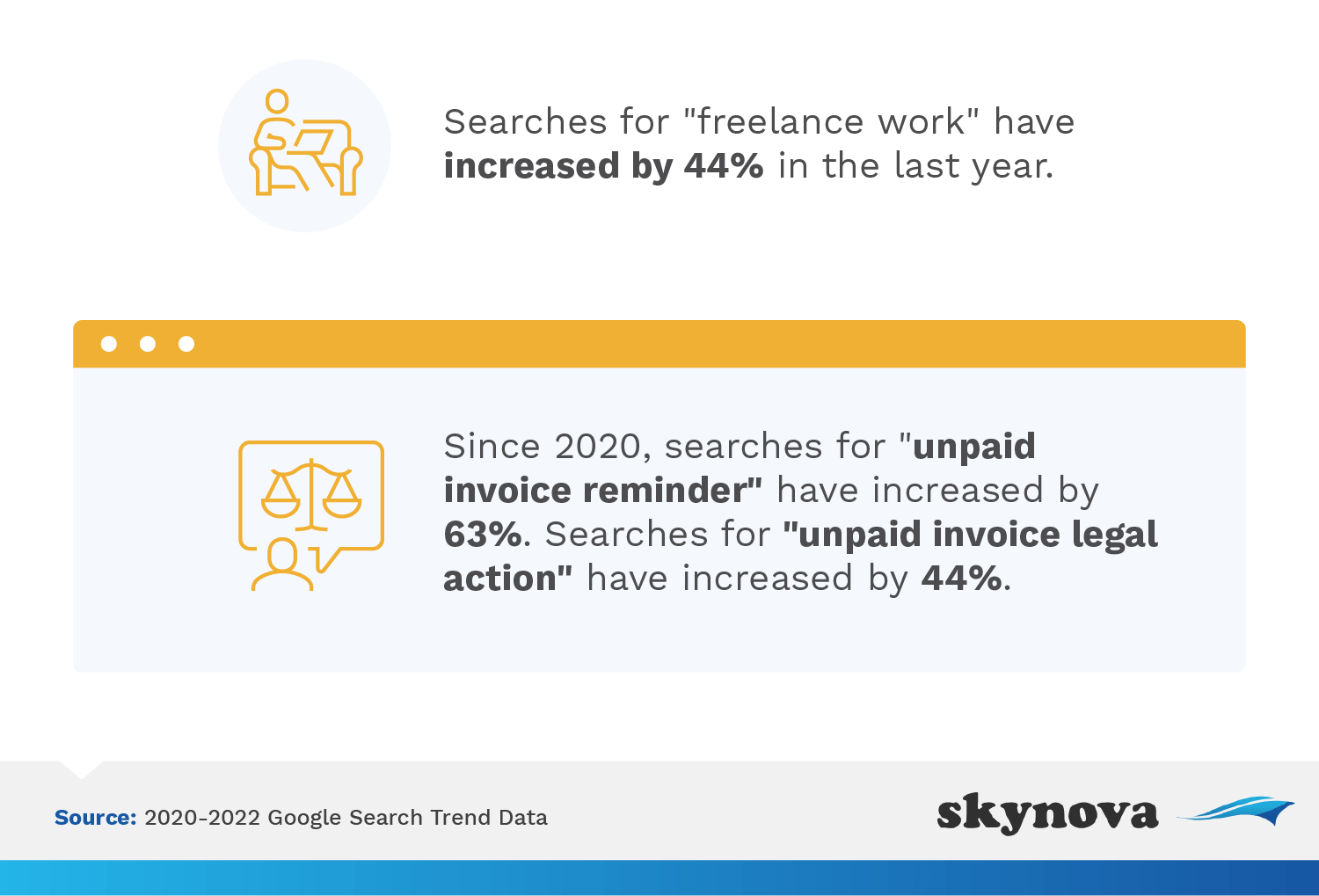
|
While older generations might have associated the entrepreneurial career path with risk, younger ones see it as a more stable option. No job is recession-proof, but working with multiple clients allows freelancers to rely on various income sources, allowing for a fallback plan in case an employer lays them off. Maybe that's why researchers expect half of the U.S. workforce to be freelancing by 2027.
But unfortunately, not all employers treat freelancers like they would full-time employees. Without a steady paycheck, these contract workers often go unpaid, creating more work for them by requiring that they follow up with clients for payment. Even worse, they sometimes must pursue legal action in order to get it. Is it worth it to jump through these extra hoops and have to pay more taxes to work as an independent contractor?
In this article, we'll outline what motivates people to start freelancing and how they react to the headaches they encounter along the way. Read on to find out what it's really like to freelance in the U.S. today.
While some people freelance as a side gig, others do it full-time. Let's get a sense of these workers' primary motivations for freelancing and the most reliable gigs.

The most common reasons to start freelancing were to pay bills, increase savings, and keep up with rising costs due to inflation. As nearly three-quarters of respondents (73%) said they could remain financially comfortable from freelancing alone, it's no wonder this work style is on the rise. In five years, a projected 86.5 million Americans will be freelancing, making up about half of the U.S. workforce. As a result, business leaders must prepare for the consequences of a freelancer-dominated market by pivoting to accommodate these new-age workers.
This may be more true for some industries than others. All the PR and branding professionals we surveyed said they could comfortably pay their bills by freelancing alone. This finding tells us that businesses needing those services might want to get ready to work with more freelancers soon, if they haven't already.
But while contractors working in PR and branding have been getting the most work, they also reported working much longer weeks than anyone else, almost 37 hours on average per week. Comparatively, SEO professionals spend far less time in the office: 97% support themselves entirely by freelancing and work about 24 hours less per week — 12.6 on average! In fact, they work fewer hours than freelancers in any profession we studied.
Though many freelancers make a steady living, they sometimes need to hound their clients for what they're rightfully owed. Who's most likely to get ghosted, and what do freelancers do to ensure that doesn't happen?

As nearly 80% of respondents have done work without compensation, employers clearly feel entitled to take advantage of freelancers. Freelance coders, SEO professionals, writers, and creative designers have dealt with this the most often; they have had to send multiple texts and emails and make repeated calls to secure payment. Some freelancers have even shown up to a client's door or taken legal action against them for unpaid work.
Luckily, government bodies, like the New York City Council, have recognized the need for freelancer protection. The Freelance Isn't Free Act took effect in 2017, outlining fundamental rights for freelance workers. As a result, freelancers in New York City now have the right to a written contract, timely and complete payment, and protection against client retaliation. If a work contractor violates any of these rights, freelancers may be entitled to compensation.
We know freelancing across the country is rising, but which states are most interested? We've analyzed online searches of related terms to find out.
Nobody conducted more freelance-related searches than people in Florida. In Tampa Bay alone, freelance workers brought in about $2.8 billion in revenue in 2021, about $400 million more than the prior year. The average independent worker also made around $40,000 annually, up from $37,691 the year before.
Meanwhile, Virginia ranked second for all searches except for 'freelancer rights'. Considering that more than half of the searches we studied pertained to unpaid work, freelancers (and those interested in it) in Virginia are likely well aware of the compensation-related headaches that come with it. Much of the eastern half of the U.S. also understands the situation, as it's where most of the freelance-related searches came from overall.

Freelancers in the U.S. are making a name for themselves at a rapid pace. Half of the country will be freelancing in five years, and we expect their primary motivations to stem from seeking financial stability. Adopting a freelance lifestyle is feasible in just about any industry.
Whichever profession you freelance in, get ready to run into irresponsible clients who won't pay what you're owed. To recoup your missing cash, you might need to text, email, or call clients. Worst-case scenario, you might have to pursue legal action against them. New York City has already put protections in place against this — will other cities follow suit?
Skynova helps small businesses speed up and simplify their internal processes by providing intuitive templates for invoicing, estimates, quotes, and more.
We surveyed 1,000 freelancers in the U.S. to explore their employment situation; 64% were male, and 36% were female. Of them, 27% were coders or programmers, 24% were marketing professionals, 18% were creative designers, 8% were accountants, 7% were HR managers, 6% were writers, 4% were language translators, 3% were SEO professionals, 3% were videographers, and 1% were PR/branding specialists. We also collected Google search volume data from 2020-2022 for each state.
If you enjoyed reading about the state of freelancing across the country, feel free to share our findings with anyone you'd like. We only ask that if you do so for noncommercial purposes, please provide a link to this page.